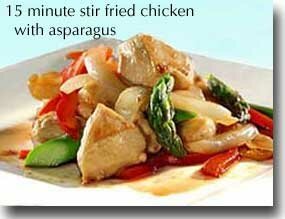healthy food tip and recipe
Today's Recipe
If you don't know what to serve for dinner tonight ...
The chicken and asparagus combination in this recipe is a wonderful addition to your Healthiest Way of Eating. It not only tastes great but contains just 275 calories!

Ingredients:
- 1 medium onion, cut in half and sliced medium thick
- 3 medium cloves garlic, pressed
- 1 TBS chicken broth
- 1 TBS minced fresh ginger
- 1 large boneless, skinless chicken breasts, cut into 1 inch pieces
- 1 bunch asparagus, cut into 1-inch pieces (about 2 cups when cut)
- 2 TBS soy sauce
- 1 TBS rice vinegar
- pinch red chili flakes
- salt and white pepper to taste
- Cut onion and mince garlic and let both sit for at least 5 minutes to bring out their hidden health benefits.
- Heat 1 TBS broth in a 12-inch stainless steel skillet. Healthy Sauté onion in broth for about 2 minutes over medium-high heat, stirring constantly.
- Add ginger, garlic, chicken, and continue to Healthy Sauté for another 3-4 minutes, stirring constantly.
- Add asparagus, soy sauce, vinegar, and red chili flakes. Stir together and cover. Cook for another 2-3 minutes. This may have to cook for an extra couple minutes if the asparagus is thick. Season with salt and pepper to taste.
- Brown rice
- Cucumber, Seaweed Salad
In-Depth Nutritional Profile for 15-Minute Healthy Sautéed Chicken & Asparagus
Healthy Food Tip
What are the anti-fungal properties of honey and how they are affected by cooking or freezing?
I've only seen a few high-quality research studies on the anti-fungal properties of honey, but they suggest that many different types of molecules in honey may be involved with this anti-fungal effect. For example, some honey (particularly honey from darker honeycombs) contains propolis, a complicated resin-like substance that is sometimes called "bee glue." Many aromatic acids, as well as benzyl cinnamate, methyl cinnamate, caffeic acid, cinnamyl cinnamate, cinnamoylglcine, terpenoids, and other molecules are contained in propolis, and all of these may be involved in its anti-fungal activity. In addition, there may be special proteins in honey that have this kind of property.
I haven't seen studies that report nutrient changes following the cooking versus freezing of honey. In general, however, heat and cold have very different effects on the nutritional value of food. There is almost always more nutrient loss with heat than with cold. Heating would be likely to damage most, if not all, of the beneficial molecules found in honey. Freezing would damage some of these molecules but not others. If you were to compare freezing to cooking honey, freezing would definitely have the lesser impact of the two processes.
It is also important to remember that the overall quality of the honey is very important and organically produced honey is the best choice in this regard. In fact, I would feel better about the purchase of a high-quality, organically produced but pasteurized honey than I would about the purchase of a raw honey of unknown quality.

No comments:
Post a Comment